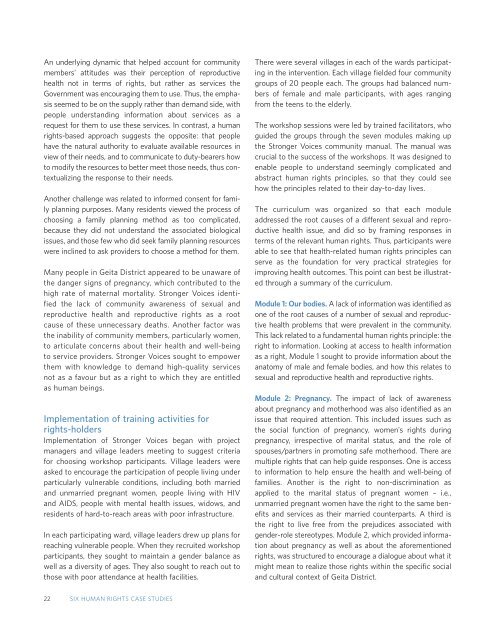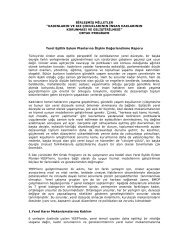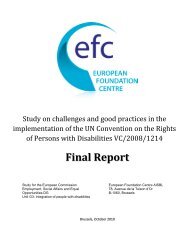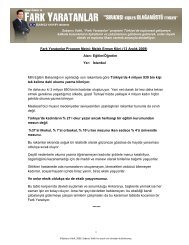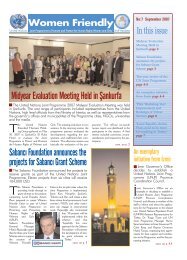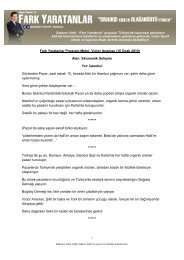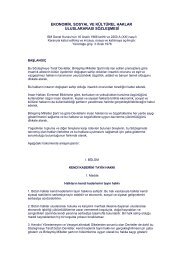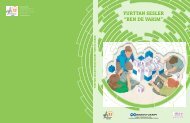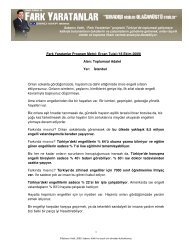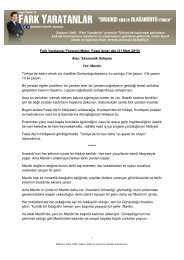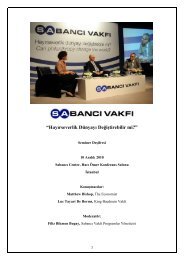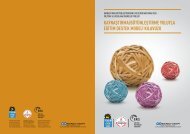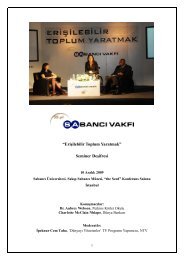UNFPA at Work: Six Human Rights Case Studies
UNFPA at Work: Six Human Rights Case Studies
UNFPA at Work: Six Human Rights Case Studies
- No tags were found...
You also want an ePaper? Increase the reach of your titles
YUMPU automatically turns print PDFs into web optimized ePapers that Google loves.
An underlying dynamic th<strong>at</strong> helped account for communitymembers’ <strong>at</strong>titudes was their perception of reproductivehealth not in terms of rights, but r<strong>at</strong>her as services theGovernment was encouraging them to use. Thus, the emphasisseemed to be on the supply r<strong>at</strong>her than demand side, withpeople understanding inform<strong>at</strong>ion about services as arequest for them to use these services. In contrast, a humanrights-based approach suggests the opposite: th<strong>at</strong> peoplehave the n<strong>at</strong>ural authority to evalu<strong>at</strong>e available resources inview of their needs, and to communic<strong>at</strong>e to duty-bearers howto modify the resources to better meet those needs, thus contextualizingthe response to their needs.Another challenge was rel<strong>at</strong>ed to informed consent for familyplanning purposes. Many residents viewed the process ofchoosing a family planning method as too complic<strong>at</strong>ed,because they did not understand the associ<strong>at</strong>ed biologicalissues, and those few who did seek family planning resourceswere inclined to ask providers to choose a method for them.Many people in Geita District appeared to be unaware ofthe danger signs of pregnancy, which contributed to thehigh r<strong>at</strong>e of m<strong>at</strong>ernal mortality. Stronger Voices identifiedthe lack of community awareness of sexual andreproductive health and reproductive rights as a rootcause of these unnecessary de<strong>at</strong>hs. Another factor wasthe inability of community members, particularly women,to articul<strong>at</strong>e concerns about their health and well-beingto service providers. Stronger Voices sought to empowerthem with knowledge to demand high-quality servicesnot as a favour but as a right to which they are entitledas human beings.Implement<strong>at</strong>ion of training activities forrights-holdersImplement<strong>at</strong>ion of Stronger Voices began with projectmanagers and village leaders meeting to suggest criteriafor choosing workshop participants. Village leaders wereasked to encourage the particip<strong>at</strong>ion of people living underparticularly vulnerable conditions, including both marriedand unmarried pregnant women, people living with HIVand AIDS, people with mental health issues, widows, andresidents of hard-to-reach areas with poor infrastructure.In each particip<strong>at</strong>ing ward, village leaders drew up plans forreaching vulnerable people. When they recruited workshopparticipants, they sought to maintain a gender balance aswell as a diversity of ages. They also sought to reach out tothose with poor <strong>at</strong>tendance <strong>at</strong> health facilities.There were several villages in each of the wards particip<strong>at</strong>ingin the intervention. Each village fielded four communitygroups of 20 people each. The groups had balanced numbersof female and male participants, with ages rangingfrom the teens to the elderly.The workshop sessions were led by trained facilit<strong>at</strong>ors, whoguided the groups through the seven modules making upthe Stronger Voices community manual. The manual wascrucial to the success of the workshops. It was designed toenable people to understand seemingly complic<strong>at</strong>ed andabstract human rights principles, so th<strong>at</strong> they could seehow the principles rel<strong>at</strong>ed to their day-to-day lives.The curriculum was organized so th<strong>at</strong> each moduleaddressed the root causes of a different sexual and reproductivehealth issue, and did so by framing responses interms of the relevant human rights. Thus, participants wereable to see th<strong>at</strong> health-rel<strong>at</strong>ed human rights principles canserve as the found<strong>at</strong>ion for very practical str<strong>at</strong>egies forimproving health outcomes. This point can best be illustr<strong>at</strong>edthrough a summary of the curriculum.Module 1: Our bodies. A lack of inform<strong>at</strong>ion was identified asone of the root causes of a number of sexual and reproductivehealth problems th<strong>at</strong> were prevalent in the community.This lack rel<strong>at</strong>ed to a fundamental human rights principle: theright to inform<strong>at</strong>ion. Looking <strong>at</strong> access to health inform<strong>at</strong>ionas a right, Module 1 sought to provide inform<strong>at</strong>ion about thean<strong>at</strong>omy of male and female bodies, and how this rel<strong>at</strong>es tosexual and reproductive health and reproductive rights.Module 2: Pregnancy. The impact of lack of awarenessabout pregnancy and motherhood was also identified as anissue th<strong>at</strong> required <strong>at</strong>tention. This included issues such asthe social function of pregnancy, women’s rights duringpregnancy, irrespective of marital st<strong>at</strong>us, and the role ofspouses/partners in promoting safe motherhood. There aremultiple rights th<strong>at</strong> can help guide responses. One is accessto inform<strong>at</strong>ion to help ensure the health and well-being offamilies. Another is the right to non-discrimin<strong>at</strong>ion asapplied to the marital st<strong>at</strong>us of pregnant women – i.e.,unmarried pregnant women have the right to the same benefitsand services as their married counterparts. A third isthe right to live free from the prejudices associ<strong>at</strong>ed withgender-role stereotypes. Module 2, which provided inform<strong>at</strong>ionabout pregnancy as well as about the aforementionedrights, was structured to encourage a dialogue about wh<strong>at</strong> itmight mean to realize those rights within the specific socialand cultural context of Geita District.22SIX HUMAN RIGHTS CASE STUDIES


